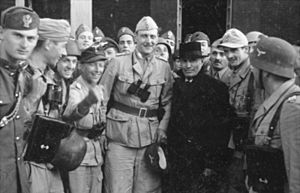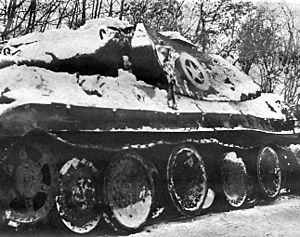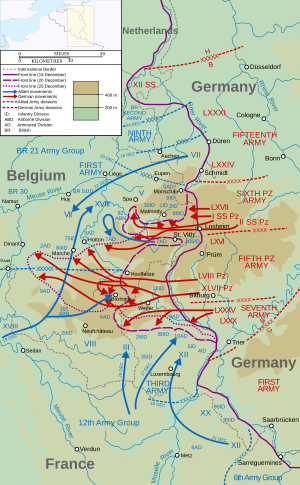Operation Greif facts for kids
Operation Greif (which means "Griffin" in English) was a secret mission during World War II. It happened during the Battle of the Bulge. Adolf Hitler himself came up with the idea for this operation.
The main goal was to capture bridges over the Meuse River before Allied forces could blow them up. German soldiers were supposed to dress in captured British and U.S. Army uniforms. They would also use captured Allied vehicles. Their job was to sneak behind enemy lines and cause lots of confusion.
This special mission was led by a German commando named Otto Skorzeny. However, the operation faced many problems. There weren't enough vehicles, uniforms, or proper equipment. Because of these issues, Operation Greif never reached its main goal of taking the Meuse bridges.
After the war, Skorzeny was put on trial. This trial helped to clarify a rule in the Geneva Convention. It stated that if German soldiers took off their Allied uniforms before fighting, they would not be seen as spies.
Contents
Operation Greif: A Secret Mission in WWII
Otto Skorzeny became one of Hitler's favorite commanders. This happened after he successfully rescued Benito Mussolini in Operation Oak. He also helped kidnap the son of Hungary's leader in Operation Panzerfaust.
In October 1944, Hitler called Skorzeny to his headquarters. Hitler told him about a big attack plan called the Ardennes Offensive. He wanted Skorzeny to play a special part in it. Hitler mentioned that American forces had used captured German tanks in a previous battle. He wanted Skorzeny to do something similar.
Skorzeny was ordered to create a special unit called Panzer Brigade 150. Their main job was to capture bridges over the Meuse River. Hitler believed this could be done faster and with fewer losses if Skorzeny's men wore U.S. uniforms. He also thought small groups in enemy uniforms could cause great chaos. They could give false orders, mess up communications, and send troops in the wrong direction.
Hitler told Skorzeny:
I want you to command a group of American and British troops and get them across the Meuse and seize one of the bridges. Not, my dear Skorzeny, real Americans or British. I want you to create special units wearing American and British uniforms. They will travel in captured Allied tanks. Think of the confusion you could cause! I envisage a whole string of false orders which will upset communications and attack morale.
Skorzeny knew this was risky. Under the rules of war, any of his men caught in U.S. uniforms could be executed as spies. This concern caused much discussion with other German generals.
Forming Panzer Brigade 150
Skorzeny had only about five or six weeks to get his new unit ready. He quickly sent his plans for Panzer Brigade 150 to the German high command. He asked for 3,300 men and was given the green light.
An order went out asking for soldiers who knew English, especially American slang. This request quickly became known to the Allies. The new brigade needed U.S. Army vehicles, weapons, and uniforms. They asked for many tanks, armored cars, jeeps, and trucks.
However, the equipment they received was far less than needed. They got only two old Sherman tanks. Skorzeny had to use German vehicles instead, like five Panther tanks and six armored cars. Many of the supplies sent were also wrong, like Polish and Russian equipment.
To make things harder, only about 10 of his men spoke perfect English. Another 30-40 spoke English well but didn't know American slang. Most of his men spoke little to no English at all.
Because of these problems, Skorzeny made the brigade smaller. He formed a special commando unit called Einheit Stielau. This unit had the 150 best English speakers. In total, about 2,500 men were gathered for the mission.
The equipment was still limited. Only enough U.S. weapons were found for the commando unit. They also had only a few U.S. scout cars, jeeps, and trucks. German vehicles were painted to look like U.S. ones. The German Panther tanks were even disguised as M10 tank destroyers.
It was very important for German forces to recognize their own disguised troops. They used special signals. These included a small yellow triangle on their vehicles, specific gun positions for tanks, and colored scarves for soldiers.
As the brigade got ready, many rumors spread about their mission. It wasn't until December 10 that Skorzeny's commanders learned the real plan. Panzer Brigade 150 was to capture bridges over the Meuse River at Amay, Huy, and Andenne.
The Einheit Stielau Mission
The Einheit Stielau commando unit had the best English speakers. But most of them had little experience with secret missions or sabotage. There wasn't much time to train them properly.
They received quick lessons in demolition and radio use. They also studied the U.S. Army's organization and ranks. Some were even sent to prisoner-of-war camps to practice their English with U.S. prisoners.
These commandos dressed in U.S. Army uniforms, with the highest rank being colonel. They used U.S. Army weapons and jeeps. They had three main tasks:
- Demolition teams of five or six men were to destroy bridges, ammunition, and fuel supplies.
- Reconnaissance patrols of three or four men were to scout areas. They would also give fake orders to U.S. units, change road signs, and remove minefield warnings.
- "Lead" commando units would work with attacking German troops. They would cut telephone wires, destroy radio stations, and issue false orders.
Operation Greif in Action
On December 14, Panzer Brigade 150 moved out. They followed behind three German Panzer divisions. The plan was for Skorzeny's unit to move around these divisions once they reached a certain area. However, the lead Panzer division was delayed. Skorzeny soon realized that Operation Greif's original goals could not be met.
On December 17, Skorzeny suggested using his brigade as a regular army unit. This was agreed upon. His unit was then ordered to help in the fighting near Malmedy. On December 21, Skorzeny's brigade tried to take Malmedy. But U.S. defenders successfully fought them off. This was the only major attempt by the Germans to capture Malmedy during the battle.
The Commandos' Impact
Skorzeny later described what the Einheit Stielau commandos did. Several commando teams were sent out in the first few days. Some went with the main German divisions.
One team entered Malmedy on December 16. Another team convinced a U.S. Army unit to leave a town in Belgium. Another team switched road signs, sending an entire U.S. regiment in the wrong direction.
Because of these actions, U.S. troops became very suspicious. They started asking other soldiers questions that only Americans would know. These questions included naming state capitals or sports trivia. This led to some funny, but also serious, situations. A U.S. general was held at gunpoint for saying the wrong baseball league for the Chicago Cubs. Another captain was detained for wearing German boots. General Omar Bradley was often stopped at checkpoints and asked trivia questions.
The fear of Skorzeny's commandos also led to tragic mistakes. U.S. soldiers sometimes fired on their own troops by accident. On December 20, two U.S. soldiers were killed by a nervous military policeman. Later, on January 2, 1945, more U.S. soldiers were killed or wounded in a friendly fire incident.
In total, 44 German soldiers in U.S. uniforms went behind enemy lines. Most of them returned safely. After December 19, the element of surprise was gone. The German commandos then went back to wearing their own uniforms. It was not uncommon for armies to send scout units behind enemy lines. But because of Operation Greif, many such events were blamed on Skorzeny's men. Also, regular German soldiers often picked up U.S. clothing they found. So, some German troops might have been captured wearing U.S. uniform items.
The Eisenhower Rumor
Operation Greif caused so much confusion that the U.S. Army "saw spies everywhere." A big panic started when a German commando team was captured on December 17. One of the captured soldiers, Wilhelm Schmidt, spread a rumor. He claimed that Skorzeny planned to capture General Dwight Eisenhower and his staff.
A document about Operation Greif's deception tactics had been captured earlier. Since Skorzeny was already famous for his daring missions, the Americans believed the story. General Eisenhower was reportedly "unamused" and had to spend Christmas 1944 isolated for safety. After a few days, he angrily left his office, saying he didn't care if anyone tried to kill him.
Aftermath and Legal Impact
Some of the captured German commandos were put on trial. They were found guilty and executed. These trials were carried out by the U.S. First Army.
After World War II, Skorzeny himself was tried as a war criminal in 1947. He and nine of his officers were accused of breaking the laws of war. They were charged with improperly using U.S. uniforms. The accusation was that they fought while disguised and treacherously killed U.S. soldiers. They were also accused of wrongly getting U.S. uniforms and Red Cross parcels meant for prisoners of war.
However, the military court found all the defendants not guilty. The court made an important distinction. It said there was a difference between using enemy uniforms during combat and using them for other purposes, like deception. It could not be proven that Skorzeny had ordered his men to fight while wearing U.S. uniforms.
Skorzeny stated that German legal experts told him it was a fair "ruse of war" as long as his men did not fight in enemy uniforms. A surprise witness, a former Allied agent, even testified that he and his team had worn German uniforms behind enemy lines. This trial helped set a legal precedent about the rules of war regarding uniforms.
See also
- Gleiwitz incident of 1939
- Hitler's Commando Order of 1942
- Shibboleth, the practice of using pronunciation or cultural knowledge to differentiate friends from military enemies




